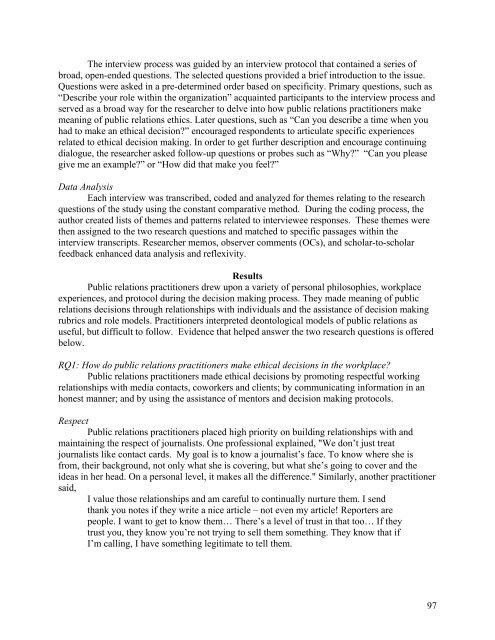2008 PROCEEDINGS - Public Relations Society of America
2008 PROCEEDINGS - Public Relations Society of America
2008 PROCEEDINGS - Public Relations Society of America
Create successful ePaper yourself
Turn your PDF publications into a flip-book with our unique Google optimized e-Paper software.
The interview process was guided by an interview protocol that contained a series <strong>of</strong><br />
broad, open-ended questions. The selected questions provided a brief introduction to the issue.<br />
Questions were asked in a pre-determined order based on specificity. Primary questions, such as<br />
“Describe your role within the organization” acquainted participants to the interview process and<br />
served as a broad way for the researcher to delve into how public relations practitioners make<br />
meaning <strong>of</strong> public relations ethics. Later questions, such as “Can you describe a time when you<br />
had to make an ethical decision?” encouraged respondents to articulate specific experiences<br />
related to ethical decision making. In order to get further description and encourage continuing<br />
dialogue, the researcher asked follow-up questions or probes such as “Why?” “Can you please<br />
give me an example?” or “How did that make you feel?”<br />
Data Analysis<br />
Each interview was transcribed, coded and analyzed for themes relating to the research<br />
questions <strong>of</strong> the study using the constant comparative method. During the coding process, the<br />
author created lists <strong>of</strong> themes and patterns related to interviewee responses. These themes were<br />
then assigned to the two research questions and matched to specific passages within the<br />
interview transcripts. Researcher memos, observer comments (OCs), and scholar-to-scholar<br />
feedback enhanced data analysis and reflexivity.<br />
Results<br />
<strong>Public</strong> relations practitioners drew upon a variety <strong>of</strong> personal philosophies, workplace<br />
experiences, and protocol during the decision making process. They made meaning <strong>of</strong> public<br />
relations decisions through relationships with individuals and the assistance <strong>of</strong> decision making<br />
rubrics and role models. Practitioners interpreted deontological models <strong>of</strong> public relations as<br />
useful, but difficult to follow. Evidence that helped answer the two research questions is <strong>of</strong>fered<br />
below.<br />
RQ1: How do public relations practitioners make ethical decisions in the workplace?<br />
<strong>Public</strong> relations practitioners made ethical decisions by promoting respectful working<br />
relationships with media contacts, coworkers and clients; by communicating information in an<br />
honest manner; and by using the assistance <strong>of</strong> mentors and decision making protocols.<br />
Respect<br />
<strong>Public</strong> relations practitioners placed high priority on building relationships with and<br />
maintaining the respect <strong>of</strong> journalists. One pr<strong>of</strong>essional explained, "We don’t just treat<br />
journalists like contact cards. My goal is to know a journalist’s face. To know where she is<br />
from, their background, not only what she is covering, but what she’s going to cover and the<br />
ideas in her head. On a personal level, it makes all the difference." Similarly, another practitioner<br />
said,<br />
I value those relationships and am careful to continually nurture them. I send<br />
thank you notes if they write a nice article – not even my article! Reporters are<br />
people. I want to get to know them… There’s a level <strong>of</strong> trust in that too… If they<br />
trust you, they know you’re not trying to sell them something. They know that if<br />
I’m calling, I have something legitimate to tell them.<br />
97
















